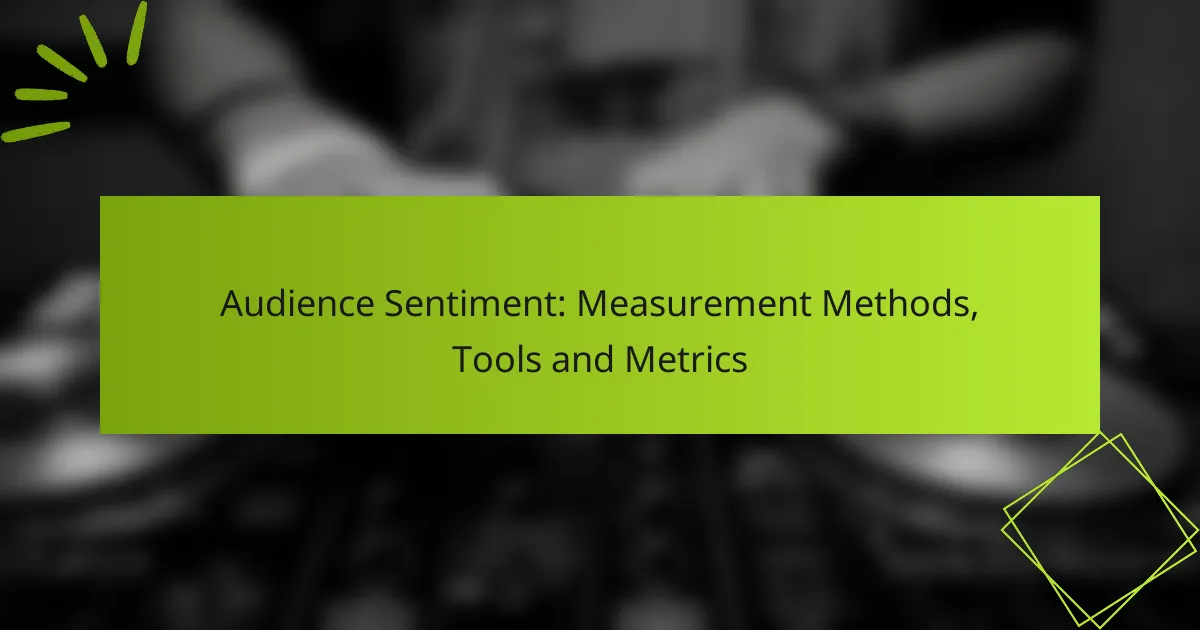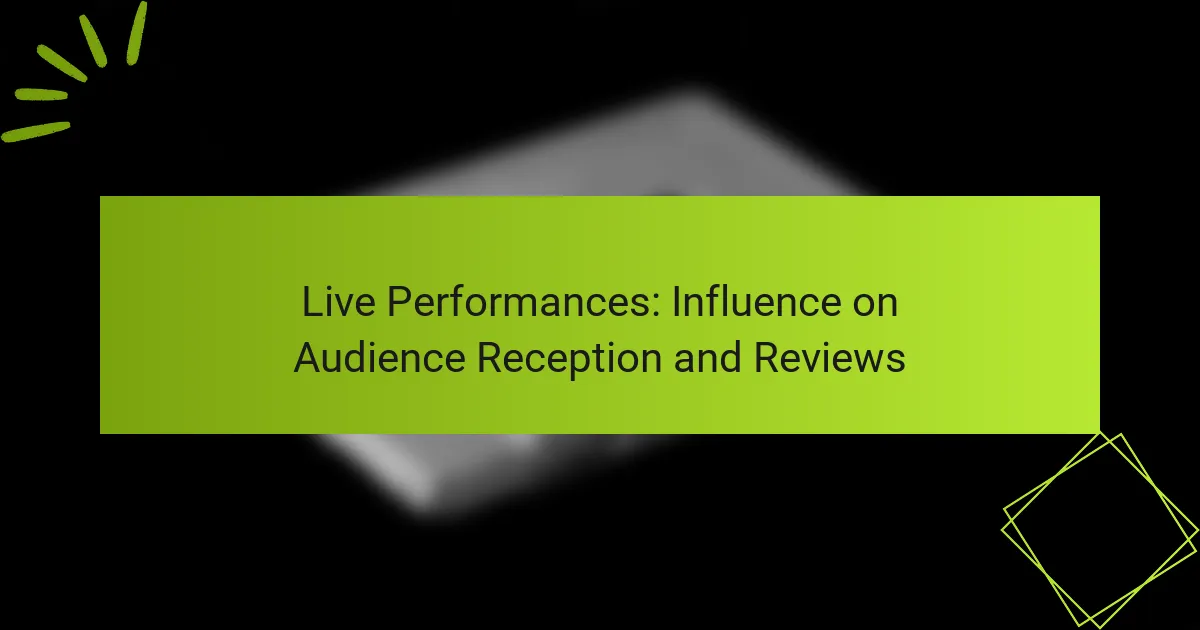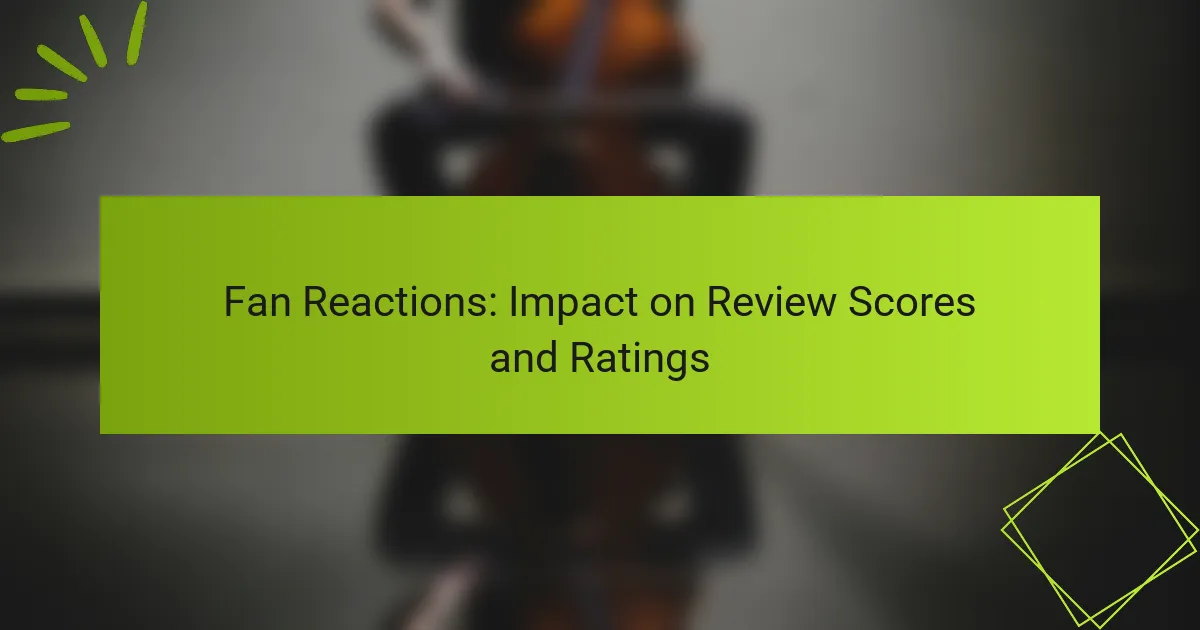Measuring audience sentiment is crucial for understanding how your audience perceives your brand, product, or service. By employing a mix of qualitative and quantitative methods, organizations can gain valuable insights into public opinion and emotional responses. Utilizing effective sentiment analysis tools and key metrics such as Net Promoter Score (NPS) and Customer Satisfaction Score (CSAT) enables businesses to make informed decisions based on audience attitudes.
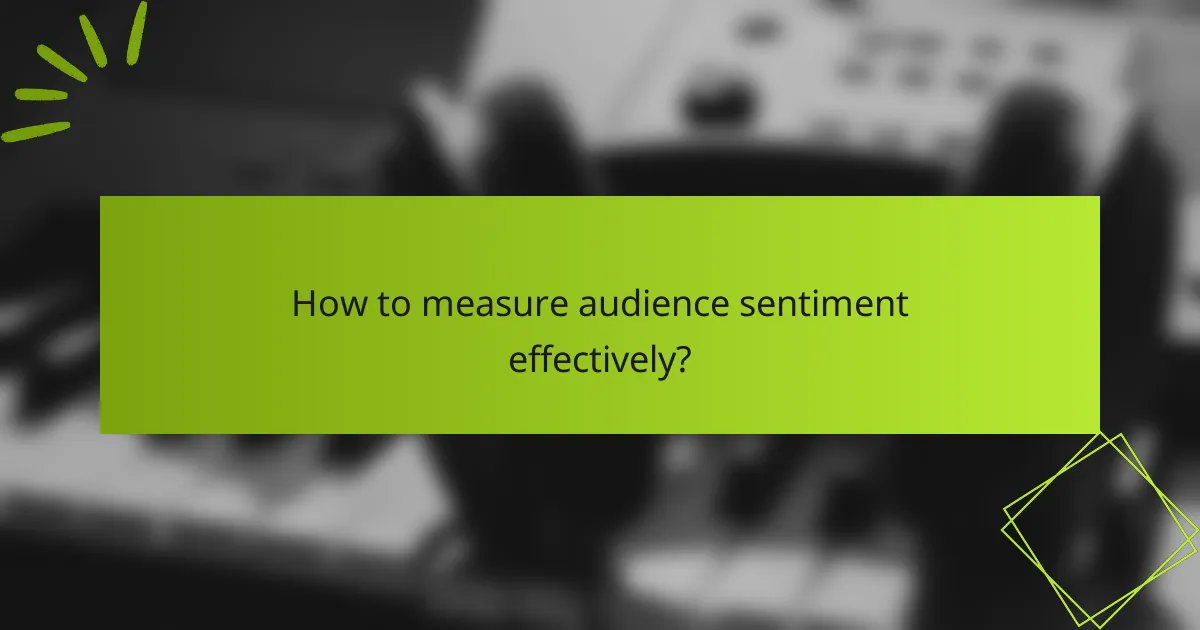
How to measure audience sentiment effectively?
Measuring audience sentiment effectively involves using various methods to gather insights into how your audience feels about your brand, product, or service. A combination of qualitative and quantitative approaches can provide a comprehensive view of audience attitudes and perceptions.
Surveys and questionnaires
Surveys and questionnaires are direct methods for measuring audience sentiment. They can be distributed online or in person and typically include a mix of open-ended and closed questions to gauge feelings and opinions.
To maximize response rates, keep surveys concise and focused, ideally taking no more than 5-10 minutes to complete. Offering incentives, such as discounts or entries into a prize draw, can also encourage participation.
Social media monitoring
Social media monitoring involves tracking mentions of your brand across platforms like Twitter, Facebook, and Instagram to understand audience sentiment. This method captures real-time feedback and can reveal trends in public opinion.
Utilize tools that analyze sentiment in posts and comments, categorizing them as positive, negative, or neutral. Regularly reviewing this data can help identify emerging issues or opportunities for engagement.
Focus groups
Focus groups provide qualitative insights by gathering a small, diverse group of participants to discuss their perceptions and feelings about a product or brand. This method allows for in-depth exploration of attitudes and motivations.
When organizing focus groups, ensure a comfortable environment and a skilled moderator to facilitate discussion. Aim for 6-10 participants to encourage interaction while keeping the group manageable.
Sentiment analysis tools
Sentiment analysis tools use algorithms to evaluate text data from various sources, including social media, reviews, and blogs, to determine audience sentiment. These tools can process large volumes of data quickly, providing valuable insights into public opinion.
When selecting a sentiment analysis tool, consider factors such as accuracy, language support, and integration capabilities with your existing systems. Many tools offer customizable dashboards to visualize sentiment trends over time.
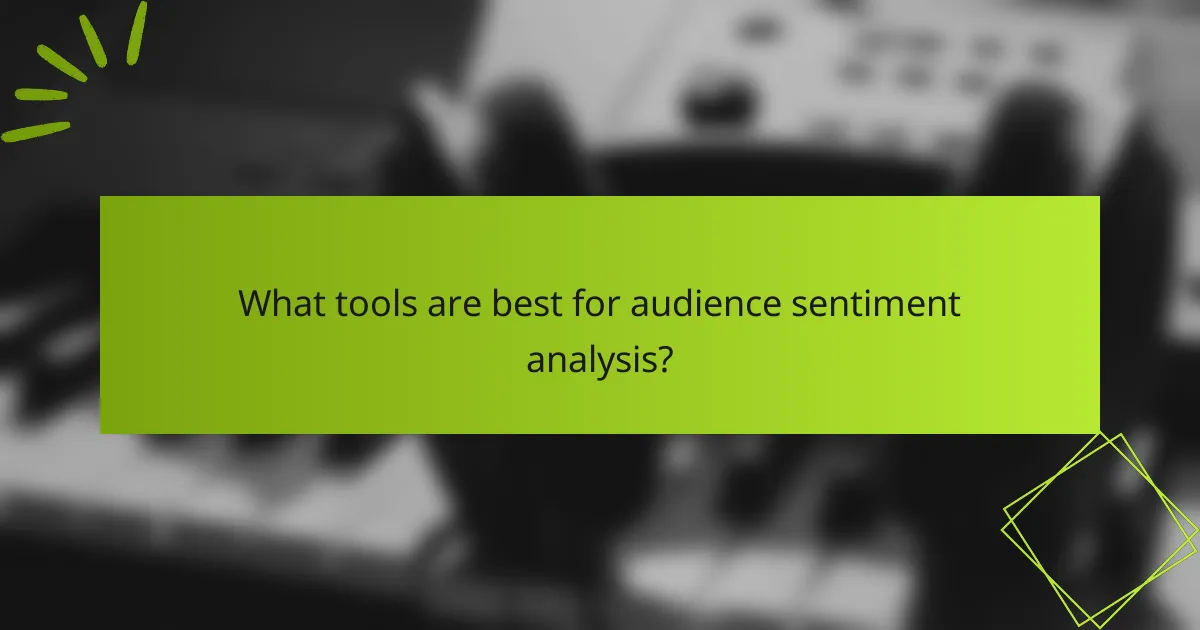
What tools are best for audience sentiment analysis?
Effective audience sentiment analysis tools help organizations gauge public opinion and emotional reactions toward their brand or products. The best tools combine data collection, analysis, and reporting features to provide actionable insights.
Qualtrics
Qualtrics is a robust platform that specializes in experience management, including audience sentiment analysis. It offers advanced survey capabilities and real-time data analysis, allowing users to capture and interpret sentiment through customizable questionnaires.
Consider using Qualtrics for in-depth sentiment studies, as it supports various question types and integrates with other data sources. However, be aware that its comprehensive features may come with a higher price point compared to simpler tools.
SurveyMonkey
SurveyMonkey is user-friendly and widely recognized for conducting surveys, making it a popular choice for audience sentiment analysis. It provides templates and question suggestions to help users quickly gather feedback.
This tool is ideal for small to medium-sized businesses looking for cost-effective solutions. Keep in mind that while it offers basic sentiment analysis features, more advanced functionalities may require a premium subscription.
Brandwatch
Brandwatch is a powerful social media monitoring tool that excels in audience sentiment analysis by analyzing online conversations. It uses artificial intelligence to assess sentiment across various platforms, providing insights into public perception.
Utilize Brandwatch for real-time monitoring and trend analysis, which can help in understanding shifts in audience sentiment. However, it may be more suited for larger organizations due to its complexity and pricing structure.
Hootsuite Insights
Hootsuite Insights offers a comprehensive view of audience sentiment through social media analytics. It aggregates data from multiple channels, allowing users to track sentiment trends over time.
This tool is beneficial for brands actively engaging on social media, as it provides actionable insights to inform marketing strategies. Be cautious of potential data overload; focus on key metrics that align with your business objectives for effective analysis.
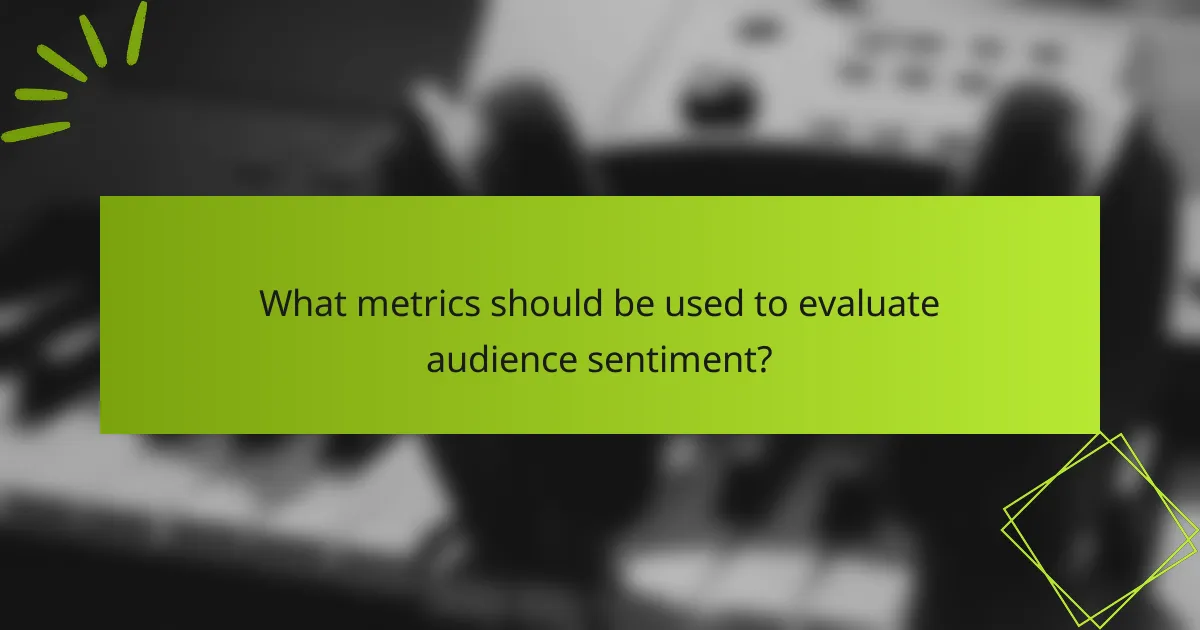
What metrics should be used to evaluate audience sentiment?
To effectively evaluate audience sentiment, consider using a combination of metrics that provide insights into customer feelings and perceptions. Key metrics include Net Promoter Score (NPS), Customer Satisfaction Score (CSAT), sentiment score, and engagement metrics, each offering unique perspectives on audience attitudes.
Net Promoter Score (NPS)
Net Promoter Score (NPS) measures customer loyalty by asking respondents how likely they are to recommend a product or service on a scale from 0 to 10. Scores are categorized into promoters (9-10), passives (7-8), and detractors (0-6), with the final NPS calculated by subtracting the percentage of detractors from promoters.
NPS is valuable for tracking changes in customer loyalty over time. A high NPS indicates a strong likelihood of referrals, while a low score may signal underlying issues that need addressing. Aim for an NPS above 50 for a healthy customer base.
Customer Satisfaction Score (CSAT)
Customer Satisfaction Score (CSAT) gauges how satisfied customers are with a specific interaction or overall experience. Typically measured through a simple survey question, respondents rate their satisfaction on a scale from 1 to 5 or 1 to 10, with higher scores indicating greater satisfaction.
CSAT is useful for identifying immediate areas for improvement. A CSAT score above 80% is generally considered good, but this can vary by industry. Regularly monitoring CSAT can help organizations respond quickly to customer feedback and enhance service quality.
Sentiment score
Sentiment score quantifies audience sentiment by analyzing text data from surveys, social media, and reviews. This score ranges from negative to positive, reflecting the overall emotional tone of customer feedback. Advanced algorithms, including natural language processing, are often used to derive these scores.
Using sentiment analysis tools can help organizations identify trends and shifts in audience feelings. A sentiment score above 0 indicates positive sentiment, while a score below 0 suggests negativity. Regularly assessing sentiment can provide insights into customer perceptions and inform strategic decisions.
Engagement metrics
Engagement metrics track how actively customers interact with a brand across various channels, including social media, email, and websites. Key metrics include likes, shares, comments, click-through rates, and time spent on site, all of which indicate how well content resonates with the audience.
High engagement levels often correlate with positive sentiment, as they suggest that customers find value in the content. Monitor these metrics regularly to understand audience preferences and tailor content strategies accordingly. Aim for consistent engagement growth to foster a loyal customer base.

What are the prerequisites for effective sentiment measurement?
Effective sentiment measurement requires a clear understanding of objectives, identification of the target audience, and appropriate data collection methods. These prerequisites ensure that the insights gained are relevant and actionable for decision-making.
Clear objectives
Establishing clear objectives is crucial for effective sentiment measurement. Define what you want to achieve, whether it’s understanding customer satisfaction, brand perception, or product feedback. This clarity will guide the entire measurement process and help in selecting the right tools and metrics.
For example, if the goal is to improve customer service, focus on measuring sentiment related to support interactions. This targeted approach will yield more actionable insights.
Target audience identification
Identifying the target audience is essential for gathering relevant sentiment data. Determine who your audience is based on demographics, behaviors, and preferences. This will help tailor your measurement approach to capture the sentiments of those most affected by your products or services.
Utilize customer personas or segmentation strategies to ensure that the sentiment analysis reflects the views of key stakeholders, such as loyal customers or potential buyers.
Data collection methods
Choosing the right data collection methods is vital for accurate sentiment measurement. Common techniques include surveys, social media monitoring, and online reviews. Each method has its strengths and weaknesses, so consider factors like reach, cost, and the type of insights needed.
For instance, surveys can provide direct feedback but may have lower response rates, while social media monitoring can capture real-time sentiments but may require advanced tools for analysis. Balancing these methods can enhance the overall effectiveness of your sentiment measurement strategy.
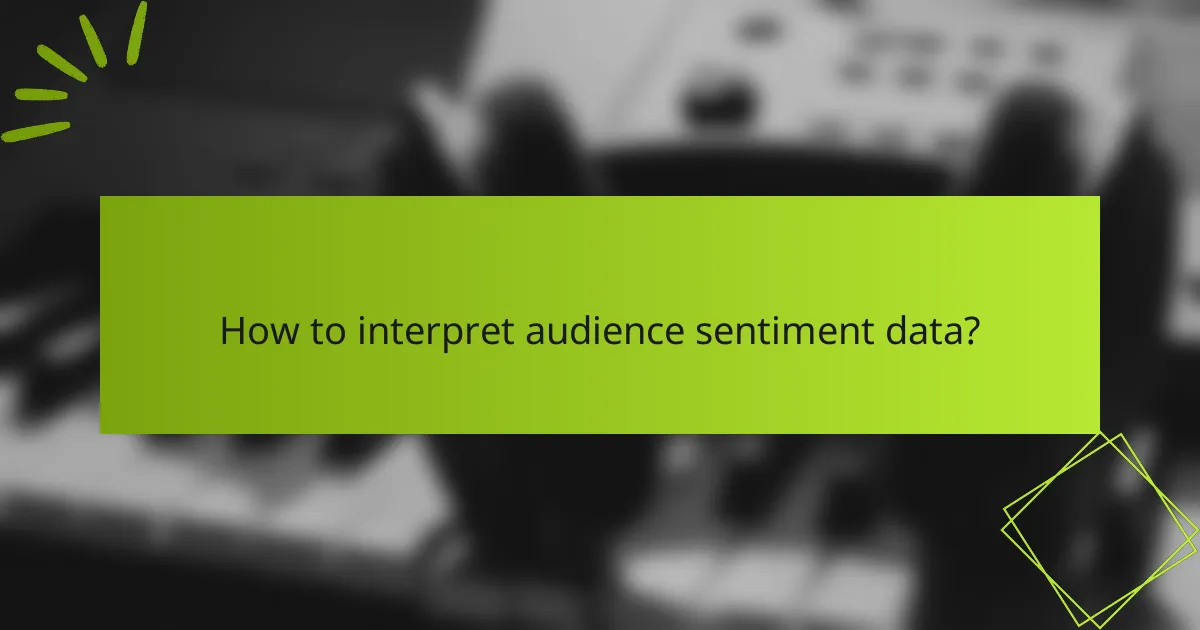
How to interpret audience sentiment data?
Interpreting audience sentiment data involves analyzing feedback to gauge public opinion and emotional responses toward a brand or content. This process helps organizations understand their audience’s feelings, enabling them to make informed decisions and improve engagement.
Understanding sentiment analysis tools
Sentiment analysis tools use natural language processing (NLP) to evaluate text data from various sources, such as social media, reviews, and surveys. These tools categorize sentiments as positive, negative, or neutral, providing a snapshot of audience feelings. Popular tools include Brandwatch, Hootsuite Insights, and Google Analytics, each offering unique features and capabilities.
When selecting a sentiment analysis tool, consider factors like ease of use, integration with existing systems, and the ability to analyze multiple languages. Some tools may offer advanced features like emotion detection or trend analysis, which can enhance your understanding of audience sentiment.
Key metrics for measuring sentiment
Key metrics for measuring sentiment include sentiment score, volume of mentions, and engagement rates. The sentiment score quantifies audience feelings on a scale, often from -1 (very negative) to +1 (very positive). Monitoring the volume of mentions helps identify trends and spikes in sentiment, while engagement rates indicate how audiences interact with content.
To effectively track these metrics, establish a baseline for comparison and monitor changes over time. This can help identify patterns and correlations between sentiment and specific campaigns or events.
Common pitfalls in sentiment interpretation
Common pitfalls in interpreting sentiment data include over-reliance on automated tools and ignoring context. Automated sentiment analysis can misinterpret sarcasm or cultural nuances, leading to inaccurate conclusions. Always complement automated analysis with human review to ensure a more accurate understanding of audience sentiment.
Another pitfall is failing to consider the source of sentiment data. Different platforms may yield varying results due to audience demographics and engagement styles. Always analyze sentiment in the context of the platform to gain meaningful insights.
